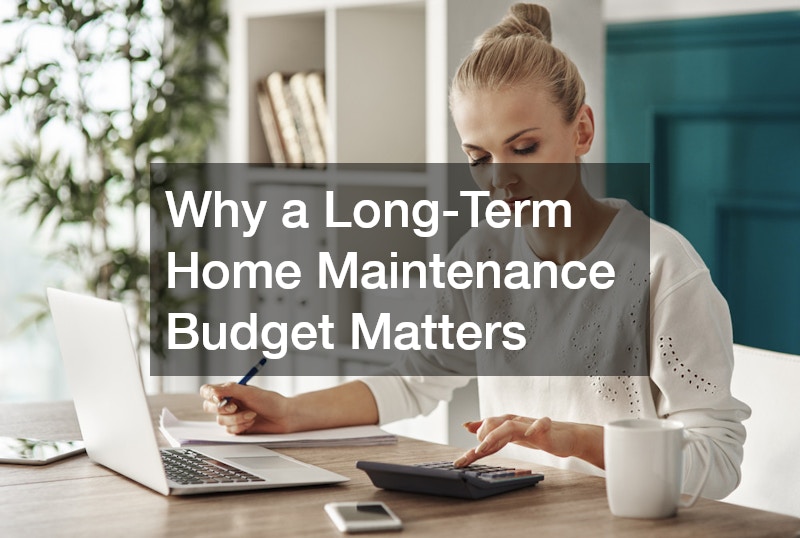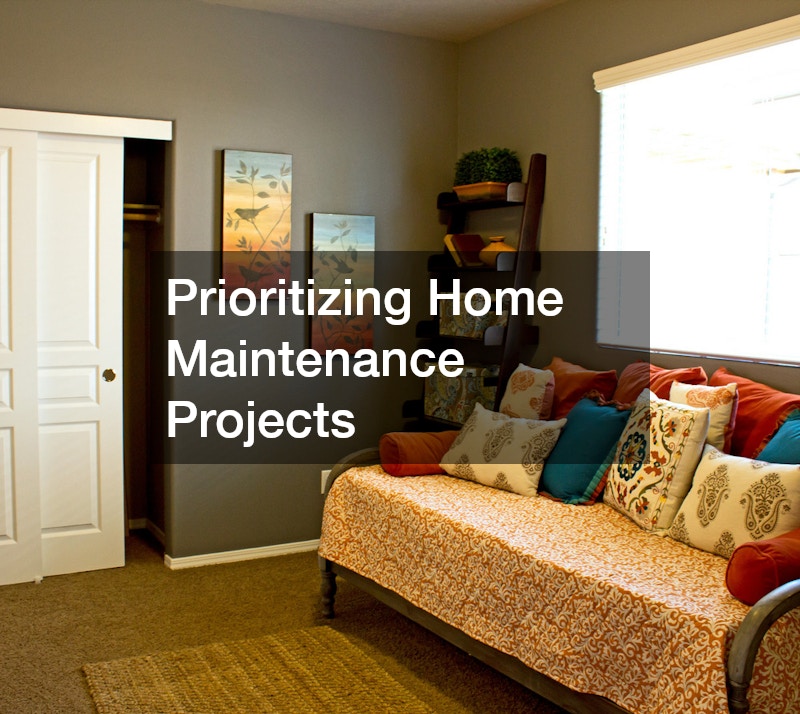Owning a home comes with a sense of pride and security, but it also comes with ongoing responsibilities that many homeowners underestimate. One of the most important obligations is maintaining the property over time. Homes age, systems wear out, and weather conditions cause deterioration that requires consistent attention. Without a thoughtful and realistic long-term maintenance budget, even small repairs can become overwhelming. Planning ahead is the key to protecting your investment and preventing costly surprises. Creating a long-term home maintenance budget empowers you to stay prepared, make strategic decisions, and keep your home safe and functional year after year.

Why a Long-Term Home Maintenance Budget Matters
Many homeowners discover too late that maintenance expenses can accumulate quickly. Roof repairs, plumbing issues, structural concerns, appliance replacements, and seasonal upkeep all require financial resources. A long-term budget helps avoid panic spending and ensures you have funds set aside for predictable and unexpected repairs.
Without a structured maintenance plan, small issues often escalate. A minor drip can turn into drywall damage. A clogged gutter can lead to water penetration. Lack of HVAC servicing can cause costly breakdowns. Budgeting ahead of time prevents crises and helps homeowners control costs rather than react to emergencies.
Long-term planning also increases home value. Homes that receive regular maintenance hold their structural integrity longer, experience fewer system failures, and present better in future real estate listings. Buyers are more likely to invest in homes with documented upkeep.
Additionally, budgeting reduces stress. When you have money set aside for inevitable repairs, you eliminate the anxiety that comes with sudden expenses. Instead of worrying about unexpected breakdowns, you can focus on routine care and quality-of-life improvements.
Some homeowners consult roofing companies when preparing for long-term exterior maintenance that may require periodic funding.
Understanding the 1%–4% Rule for Annual Budgeting
One of the most common guidelines for long-term home maintenance budgeting is the 1%–4% rule. This suggests that homeowners set aside between 1% and 4% of their home’s value each year to cover upkeep costs.
For a $350,000 home, this translates to budgeting between $3,500 and $14,000 annually. Homes located in areas with harsh weather, older homes, or properties with specialized features often require budgets closer to the high end of this range.
The age of the home influences which percentage to use. Newer homes typically require less maintenance beyond basic servicing. However, homes more than 20 years old often need more frequent system replacements, making higher percentages necessary.
Location plays a role as well. Coastal homes, regions with freeze-thaw cycles, or areas with intense heat or humidity require more maintenance funding.
The materials used in construction also make a difference. Some materials deteriorate faster or require professional attention more frequently, such as wood siding or natural stone elements. Luxury homes with complex layouts, multiple HVAC systems, or expansive landscaping can also require higher maintenance budgets.
This rule provides homeowners with a baseline estimate. From there, additional planning and detailed categorization help shape a more accurate long-term budget.
Many individuals consult siding companies when assessing the long-term upkeep costs associated with exterior wall materials.

Categorizing Maintenance Expenses for Better Planning
To create an effective long-term budget, homeowners should break expenses into specific categories. This makes the budgeting process easier to track, adjust, and manage over time.
Structural Expenses
These include roofing, siding, foundation, and exterior framework. Structural components protect the home from weather, pests, and deterioration, making them essential priorities.
Systems and Mechanical Components
This category includes HVAC units, water heaters, plumbing systems, and electrical systems. Most of these require annual servicing and eventual replacements.
Appliances and Fixtures
Large appliances—such as refrigerators, washers, dryers, and stoves—have expected lifespans and should be included in budgeting. Fixtures such as faucets, lighting, and hardware also require periodic replacement.
Interior Maintenance
Flooring repairs, drywall updates, paint refreshes, and cosmetic improvements fall into this category. While not always urgent, they contribute to comfort and property value.
Exterior and Landscaping
Driveways, fences, walkways, patios, and landscaping need consistent upkeep. Proper budgeting helps maintain curb appeal and prevents deterioration.
Emergency Funds
Unexpected issues such as storm damage, leaks, pest infestations, or system failures require additional reserves. Emergency funds provide peace of mind for these unpredictable events.
By dividing expenses into categories, homeowners gain a clearer view of the financial commitment required for upkeep.
Many homeowners rely on plumbing companies when calculating the maintenance costs associated with pipes, fixtures, and drainage systems.
Mapping Out Repair and Replacement Cycles
Every component of a home has a typical lifespan. Understanding these lifespans helps homeowners predict when replacement costs are likely to arise.
Roofing
Most roofs last between 20 and 30 years, depending on the material. Asphalt shingles have shorter lifespans, while metal or tile roofs may last longer. Budgeting ahead ensures homeowners can afford replacements when the time comes.
HVAC Systems
Heating and cooling units generally last 10–15 years. Regular maintenance can extend their lifespan, but eventual replacement is unavoidable.
Water Heaters
Traditional water heaters last 8–12 years, while tankless systems may last 15–20 years. Planning for these replacements prevents sudden financial strain.
Plumbing
Pipes, especially older metal ones, have limited lifespans. Fixtures such as faucets and valves require periodic replacement due to wear, mineral buildup, or leaks.
Electrical Systems
Panels, wiring, and outlets may need upgrading over time for safety or functional reasons. Newer homes require fewer replacements, but aging homes may demand significant updates.
Siding
Vinyl siding may last 20–40 years, while wood siding requires more frequent upkeep. Painting and sealing schedules should be part of the long-term plan.
Foundation
While foundations are built to last for decades, soil movement, moisture, and age may cause cracks or settling over time. Planning for inspections and potential repairs protects structural integrity.
Major Appliances
Most large appliances last 8–15 years. Budgeting for replacements avoids unexpected disruptions when appliances fail.
Tracking these cycles helps homeowners prepare financially. Instead of being surprised by sudden failures, they can anticipate expenses and allocate funds.
Some households budget for water heater repair as part of their long-term planning for mechanical system upkeep.

Prioritizing Home Maintenance Projects
Not all maintenance tasks carry equal urgency. A long-term budget should prioritize repairs based on safety, structural integrity, and the potential for costly damage.
High Priority: Structural and Safety Issues
- Leaking roofs
• Damaged foundations
• Faulty wiring
• Major plumbing leaks
• HVAC failures
• Pest infestations
These issues require immediate attention because they threaten the home’s stability and occupant safety.
Medium Priority: Comfort and Efficiency
- Old insulation
• Drafty windows
• Aging appliances
• Outdated HVAC filters
• Worn-out flooring
Addressing these improves comfort and energy efficiency but does not necessarily threaten safety.
Low Priority: Aesthetic Repairs
- Cosmetic updates
• Non-critical landscaping improvements
• Decorative enhancements
These can be completed as the budget allows.
Prioritizing helps homeowners allocate funds successfully. This style of planning ensures essential repairs receive funding before luxury upgrades.
Some individuals consult HVAC contractors when determining the best time to plan for heating and cooling unit replacements based on efficiency needs and system age.
Building an Emergency Repair Fund
No matter how well-maintained a home is, unexpected issues always arise. Storms, accidents, aging systems, and natural wear and tear can create sudden expenses that unprepared homeowners find overwhelming.
A standard recommendation is to maintain an emergency repair fund equal to at least 1% of the home’s value. Others recommend having three to six months’ worth of living expenses in a general emergency fund that includes home repairs.
Building this fund gradually prevents financial strain. Setting aside a small percentage of income each month contributes to a growing reserve that protects homeowners from large emergency bills.
Emergency funds also prevent homeowners from using credit cards or loans for sudden repairs. Avoiding interest-based debt makes long-term maintenance budgeting more affordable.
Some homeowners consult a foundation repair company when unexpected cracks, settling, or structural shifts require immediate professional attention.

Seasonal Maintenance and Its Impact on Budgeting
Seasonal maintenance plays a significant role in protecting the home and preventing repairs. Knowing what tasks need attention throughout the year helps homeowners allocate funds for recurring services.
Spring
- Roof inspections
• Gutter cleaning
• Exterior washing
• Yard cleanup
• HVAC servicing
Spring is ideal for identifying winter-related damage and preparing systems for warm weather.
Summer
- Pest control
• Landscaping
• Pressure washing
• Deck and fence repair
Summer tasks often involve outdoor improvements that require regular upkeep.
Fall
- Furnace servicing
• Gutter clearing
• Weatherproofing
• Roof inspections
Fall maintenance prepares the home for cold weather.
Winter
- Pipe insulation
• Roof monitoring
• Attic ventilation checks
Winter tasks help prevent freezing damage and heat loss.
By including seasonal tasks in their long-term budget, homeowners avoid being blindsided by annual maintenance needs.
Some homeowners budget for flood damage restoration in areas prone to heavy rain, melting snow, or storm surges that threaten their property.
Planning for Long-Term Improvements and Upgrades
Long-term budgeting is not only for repairs—it also includes improvements that increase property value, efficiency, and comfort.
Energy-Efficient Upgrades
Installing energy-efficient windows, adding insulation, upgrading HVAC units, or switching to LED lighting reduces long-term utility costs.
Exterior Enhancements
Homeowners may plan for repainting, siding replacement, driveway resurfacing, or porch and deck upgrades.
Interior Renovations
Bathroom remodels, kitchen upgrades, and flooring replacements add value and improve daily living.
Technology and Smart Home Systems
Security systems, smart thermostats, lighting automation, and other technologies improve convenience and efficiency.
Budgeting for these upgrades over time makes them more realistic financially.
Some property owners consult a mold removal company before making major improvements if moisture has affected interior walls, insulation, or structural components.
How to Track and Adjust Your Maintenance Budget Over Time
A long-term home maintenance budget should be dynamic. As the home ages, expenses change, and economic conditions shift, adjustments become necessary.
Track Expenses Monthly
Maintaining a spreadsheet or budgeting app helps homeowners understand where their money is going. Tracking also highlights patterns in spending and identifies areas for improvement.
Review Annually
Annual evaluations ensure the budget reflects current needs. Homeowners should consider inflation, material costs, contractor rates, and energy bills.
Adjust for Major Life Events
Income changes, family growth, or lifestyle adjustments may require changes to the budget. Renovations, additions, or home expansions also affect future maintenance expenses.
Account for Home Aging
As the home gets older, major systems begin to fail more frequently. Increasing the maintenance budget during these periods prepares homeowners for more frequent updates.
Some individuals contact a fencing company when budgeting for long-term exterior upgrades that enhance property boundaries and security.
Evaluating When to Hire Professionals vs. DIY
Many homeowners enjoy DIY projects, but long-term maintenance budgets must account for tasks requiring licensed professionals. Knowing when to handle repairs yourself and when to hire help ensures safety and quality.
DIY-Suitable Tasks
- Painting
• Minor landscaping
• Basic cleaning
• Simple fixture replacements
DIY tasks help homeowners save money on labor costs.
Professional-Only Tasks
- Electrical repairs
• Plumbing updates
• HVAC service
• Roofing repairs
• Structural work
These tasks require knowledge, experience, and proper equipment. Performing them incorrectly can lead to safety hazards or extensive damage.
Budgeting for professional labor prevents homeowners from cutting corners or taking unnecessary risks.
Some homeowners reference electrical companies when planning budgets for system upgrades, safety inspections, or wiring repairs.
How to Build a Predictive Maintenance Schedule
A predictive maintenance schedule uses data to determine when systems are most likely to need servicing. This strategy helps homeowners plan financially and avoid unexpected breakdowns.
Use Manufacturer Guidelines
Most appliances and home systems come with recommended service intervals.
Schedule Annual Inspections
Professional inspections catch hidden problems early. Roofs, HVAC systems, plumbing, and electrical components benefit from regular evaluations.
Track Repairs and Replacements
Documenting past work helps predict when future repairs will be necessary.
Assess Wear Based on Usage
High-use areas or systems require more frequent servicing.
A predictive schedule helps homeowners budget more accurately.
The Role of Preventative Maintenance in Reducing Long-Term Costs
Preventative maintenance is one of the most effective ways to minimize long-term expenses. It protects the home, improves efficiency, and reduces emergency repairs.
Examples of Preventative Maintenance
- Gutter cleaning
• HVAC servicing
• Pipe insulation
• Roof inspections
• Caulking and sealing gaps
• Pest control
Preventative tasks are often inexpensive but save homeowners thousands of dollars in future repair costs.
Incorporating Insurance Costs and Deductibles Into Your Budget
Homeowners’ insurance plays a significant role in long-term budgeting. Deductibles, exclusions, and policy limits should be considered when estimating repair expenses.
Understand Policy Coverage
Some policies do not cover mold, floods, or wear-and-tear damage.
Know Your Deductible
Homeowners should have at least the deductible saved in their emergency fund.
Evaluate Optional Coverage
Add-ons such as sewer line coverage, flood insurance, or equipment breakdown insurance can save homeowners money over time.
Insurance should be a planned part of any long-term maintenance budget.
Working with Professionals for Long-Term Planning
Professionals can help homeowners estimate future repair costs and create realistic budgets. Contractors, inspectors, and specialists offer valuable insight into the lifespan of systems and materials.
Home Inspectors
Yearly assessments help homeowners understand upcoming repairs.
Contractors
Experts provide estimates for major projects like roof replacements, siding upgrades, or HVAC installations.
Financial Planners
Some homeowners prefer assistance from financial advisors to structure their maintenance budgets.
Working with professionals prevents underbudgeting and unexpected financial strain.
Creating a long-term home maintenance budget is essential for protecting your home, controlling costs, and preventing stressful financial surprises. By understanding repair cycles, tracking expenses, planning for emergencies, and prioritizing upkeep, homeowners can maintain a safe and comfortable living environment for decades. A well-structured maintenance budget ensures your home remains strong, efficient, and valuable over time. With thoughtful planning and proactive care, you can enjoy the rewards of homeownership while staying fully prepared for whatever maintenance needs arise. Don’t wait to get in touch with local professionals, including roofing companies today!


